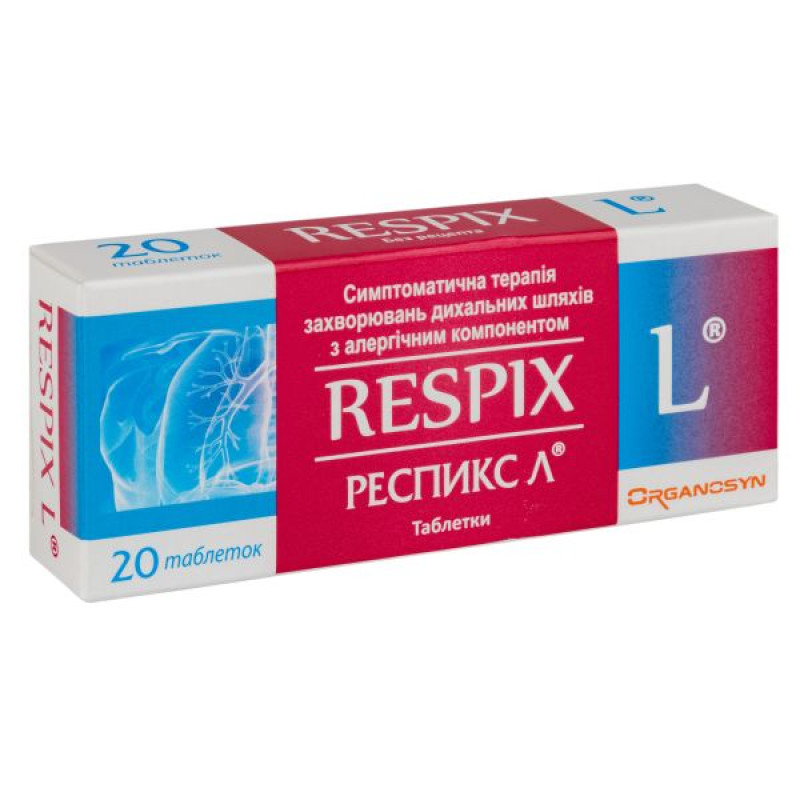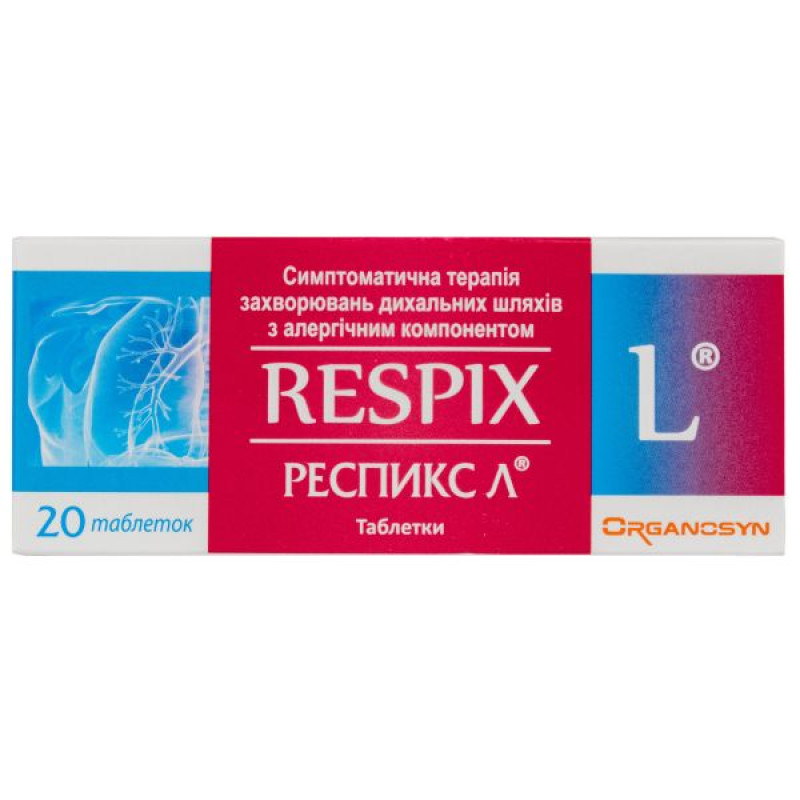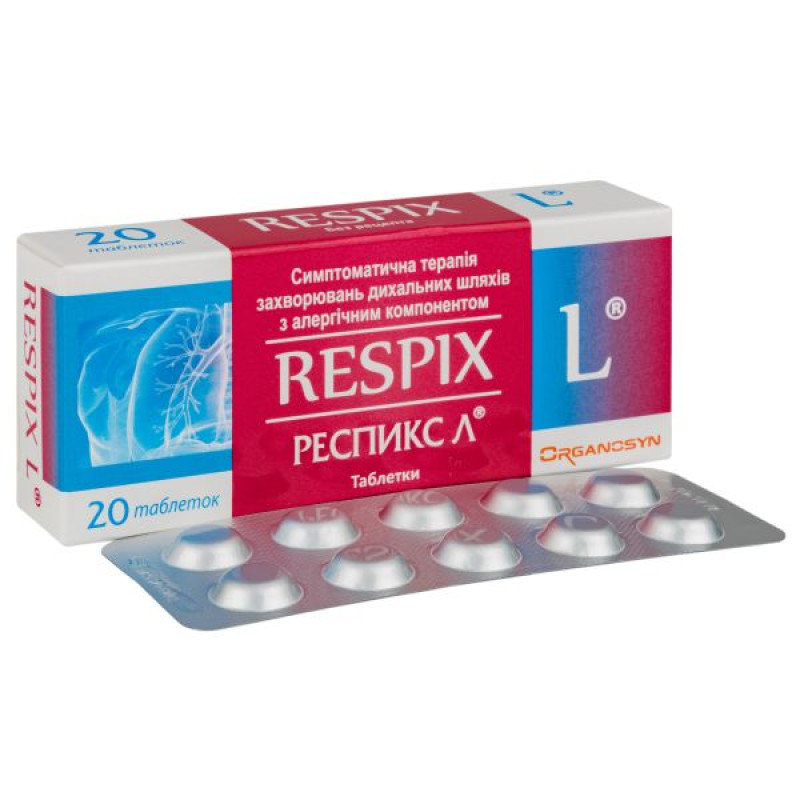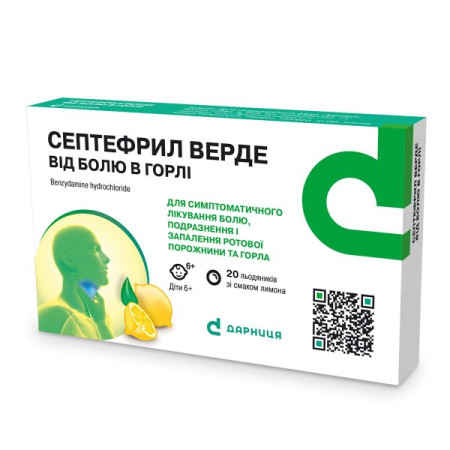Respiks L tablets blister No. 20

Instructions for Respiks L tablets blister No. 20
Composition
active ingredients: ambroxol hydrochloride, loratadine;
1 tablet contains ambroxol hydrochloride 60 mg, loratadine 5 mg;
Excipients: lactose monohydrate, corn starch, microcrystalline cellulose, povidone, magnesium stearate, colloidal anhydrous silicon dioxide, sodium starch glycolate.
Dosage form
Pills.
Main physicochemical properties: flat, round tablets, almost white in color, with a score on one side, without a shell.
Pharmacotherapeutic group
Medicines used for coughs and colds. Expectorants, except for combination preparations containing antitussives.
ATX code R05C.
Pharmacological properties
Pharmacodynamics.
Ambroxol.
Ambroxol increases the secretion of the glands of the respiratory tract, enhances the release of pulmonary surfactant by directly affecting type II pneumocytes in the alveoli and Clara cells in the bronchioles, and also stimulates ciliary activity, as a result of which mucus secretion and its excretion are facilitated (mucociliary clearance).
Activation of fluid secretion and increased mucociliary clearance facilitate mucus clearance and relieve coughing.
Improvement in mucociliary clearance has been proven in clinical and pharmacological studies.
In vitro studies have shown that ambroxol has a local anesthetic effect. This may be explained by its sodium channel blocking properties (binding was reversible and concentration-dependent).
In vitro studies have also demonstrated the anti-inflammatory effect of ambroxol, associated with a reduction in the release of cytokines from the blood and tissue binding of mononuclear and polymorphonuclear cells.
The use of ambroxol increases the concentration of antibiotics (amoxicillin, cefuroxime, erythromycin, and doxycycline) in bronchopulmonary secretions and sputum.
Loratadine.
Loratadine belongs to the tricyclic selective blockers of peripheral H1-histamine receptors. When used in the recommended dose, it does not have a clinically significant sedative and anticholinergic effect. During long-term treatment, no clinically significant changes in vital signs, laboratory tests, physical examination data or electrocardiogram were detected. Loratadine has no significant effect on the activity of H2-histamine receptors. It does not block the uptake of norepinephrine and has virtually no effect on the cardiovascular system and pacemaker activity.
Pharmacokinetics.
Ambroxol.
After oral administration of ambroxol hydrochloride is almost completely absorbed from the digestive tract. The maximum concentration is reached after 1-2.5 hours. When taken orally, the distribution of ambroxol hydrochloride from the blood to the tissues is rapid and pronounced, with the highest concentration of the active substance in the lungs. Plasma protein binding is 85% (80-90%). Ambroxol hydrochloride penetrates into the cerebrospinal fluid, through the placental barrier and into breast milk.
As a result of primary metabolism, the absolute bioavailability of ambroxol hydrochloride is reduced by 1/3. It is metabolized in the liver. About 90% of ambroxol hydrochloride is excreted by the kidneys in the form of metabolites, less than 10% - by the kidneys in unchanged form.
The plasma half-life is about 10 hours. Total clearance is within 660 ml/min. Renal clearance is approximately 83% of the total.
Dialysis or forced diuresis is not expected to enhance the elimination of ambroxol hydrochloride due to its high protein binding, large volume of distribution and slow redistribution from tissues to blood.
Special categories of patients.
In patients with impaired liver function, the excretion of ambroxol hydrochloride is reduced, resulting in a 1.3-2-fold higher plasma level. Since the therapeutic range of ambroxol hydrochloride is quite wide, no dosage adjustment is required.
Age and gender have no clinically significant effect on the pharmacokinetics of ambroxol hydrochloride, therefore no dose adjustment is required.
Food intake does not affect the bioavailability of ambroxol hydrochloride.
Loratadine.
After oral administration, loratadine is well absorbed from the gastrointestinal tract and metabolized by CYP3A4 and CYP2D6 enzymes, mainly to desloratadine. The time to reach maximum plasma concentrations of loratadine and desloratadine is 1-1.5 hours and 1.5-3.7 hours, respectively. Loratadine and its metabolite are well bound to plasma proteins. The bioavailability of loratadine and desloratadine is directly proportional to the dose. Food intake slightly prolongs the absorption time of loratadine, but does not affect the clinical effect.
The elimination half-lives of loratadine and its metabolite were 24 hours and 37 hours, respectively, and increased with the severity of liver disease.
Special categories of patients.
In patients with chronic renal failure, the pharmacokinetic parameters were not increased compared to patients with normal renal function. The elimination half-life was not significantly altered, and hemodialysis did not affect the pharmacokinetics of loratadine and its metabolites.
In patients with alcoholic liver disease, a twofold increase in loratadine pharmacokinetic parameters was observed, while the pharmacokinetic profile of the metabolite did not change compared to patients with normal liver function.
Indication
Symptomatic therapy of respiratory diseases with an allergic component associated with impaired bronchial secretion and impaired mucus clearance.
Contraindication
Hypersensitivity to the active substances or to other components of the drug.
Children under 12 years old.
Interaction with other medicinal products and other types of interactions
Concomitant use of ambroxol with alcohol or other central nervous system inhibitors may lead to drowsiness.
Ambroxol is metabolized by CYP3A4 and CYP2D6 enzymes, therefore it should be used with caution when used simultaneously with drugs metabolized by these enzymes due to possible increased adverse reactions (such as cimetidine, ketoconazole, quinidine, fluconazole, fluoxetine).
Loratadine does not enhance the inhibitory effect of alcohol on psychomotor reactions.
Concomitant use of loratadine with CYP3A4 or CYP2D6 inhibitors may lead to increased levels of loratadine, which in turn increases side effects.
With simultaneous use of loratadine with ketoconazole, erythromycin, cimetidine, an increase in the concentration of loratadine in the blood plasma was noted, but this increase was not clinically manifested, including according to electrocardiogram data.
The simultaneous use of ambroxol with cough suppressants may lead to excessive mucus accumulation due to suppression of the cough reflex. Therefore, such a combination is possible only after a careful assessment of the ratio of the expected benefit and the possible risk of use.
Application features
There have been a few reports of severe skin reactions: Stevens-Johnson syndrome and toxic epidermal necrolysis (Lyell's syndrome) associated with the use of expectorants such as ambroxol. Most of these could be explained by the severity of the underlying disease and/or the concomitant use of another drug. Also, in the initial stage of Stevens-Johnson syndrome or Lyell's syndrome, patients may experience non-specific, flu-like symptoms such as fever, aches, rhinitis, cough and sore throat. Symptomatic treatment with cough and cold medicines may be mistakenly used for such non-specific, flu-like symptoms. Therefore, if new skin or mucous membrane lesions appear, medical advice should be sought immediately and treatment with ambroxol hydrochloride should be discontinued.
The drug should be discontinued no later than 48 hours before skin diagnostic allergy tests to prevent false results.
In cases of impaired bronchial motility and increased mucus secretion (for example, in a rare disease such as primary ciliary dyskinesia), the drug should be used with caution, since ambroxol may increase mucus secretion.
Patients with impaired renal function or severe hepatic insufficiency should use the drug only after consulting a doctor. When using ambroxol, as with any active substance that is metabolized in the liver and then excreted by the kidneys, there is an accumulation of metabolites that are formed in the liver in patients with severe renal insufficiency.
The drug contains lactose, so it should not be used in people with rare hereditary problems of galactose intolerance, the Lapp lactase deficiency or glucose-galactose malabsorption.
Use during pregnancy or breastfeeding
The drug is not recommended for use during pregnancy or breastfeeding.
Ability to influence reaction speed when driving vehicles or other mechanisms
No clinical studies have been conducted on the effect of ambroxol on reaction speed when driving or using other mechanisms.
In clinical studies, loratadine did not affect the speed of reaction when driving or using other mechanisms. However, patients should be informed about very rare cases of drowsiness, which may affect the ability to drive or use other mechanisms.
Method of administration and doses
Adults and children over 12 years of age take 1 tablet 2 times a day.
However, given the different body weights of children, regardless of age, the dose of ambroxol is calculated according to body weight and is 1.2-1.6 mg/kg/day in two divided doses. The tablets should be taken after meals and washed down with sufficient fluid. The drug should not be used for longer than 4-5 days without consulting a doctor. In general, there are no restrictions on the duration of use, but long-term therapy should be carried out under medical supervision.
Children.
The drug is used in children over 12 years of age.
Overdose
The following symptoms have been observed in overdose with loratadine: drowsiness, tachycardia and headache.
Symptoms of ambroxol overdose are known from isolated reports of overdose and/or cases of medication errors and are consistent with known adverse reactions.
Treatment: symptomatic and supportive therapy. Standard measures to remove the drug from the stomach are recommended: gastric lavage, use of activated charcoal. Loratadine is not removed by hemodialysis, it is also unknown whether loratadine is removed by peritoneal dialysis.
Adverse reactions
Cardiovascular system: tachycardia, palpitations.
From the nervous system: drowsiness, headache, increased appetite, insomnia, dizziness, convulsions, dysgeusia.
Respiratory, thoracic and mediastinal disorders: rhinorrhea.
On the part of the digestive tract: nausea, vomiting, diarrhea, abdominal pain, dyspepsia, constipation, dry mouth and throat, drooling, gastritis, decreased sensitivity in the oral cavity.
Hepatobiliary system: liver dysfunction.
From the urinary system: dysuria.
Immune system, skin and subcutaneous tissue disorders: hypersensitivity reactions, including rash, mucosal reactions, urticaria, dyspnea, angioedema, pruritus, anaphylactic reactions (including anaphylactic shock), erythema, alopecia, severe skin lesions: Stevens-Johnson syndrome and toxic epidermal necrolysis (Lyell's syndrome).
General manifestations: increased fatigue, fever.
Expiration date
3 years.
Storage conditions
Store in original packaging at a temperature not exceeding 25 ° C. Keep out of the reach of children.
Packaging
10 tablets in a blister. 1 or 2 blisters in a pack.
Vacation category
Without a prescription.
Producer
Evertogen Life Sciences Limited.
Location of the manufacturer and its business address.
Plot No. S-8, S-9, S-13 and S-14, A.P.I.C, S.I.Z Pharma, Green Industrial Park, Polepally (BI), Yedcherla (EM), Mahabubnagar, IN - 509 301, India/
Plot No. S-8, S-9, S-13 & S-14, APIIC, Pharma Sez, Green Industrial Park, Polepally (V), Jadcherla (M), Mahabubnagar, In-509 301, India.
There are no reviews for this product.
There are no reviews for this product, be the first to leave your review.
No questions about this product, be the first and ask your question.













